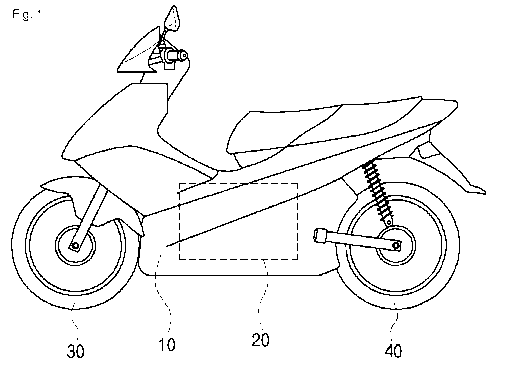Une partie des informations de ce site Web a été fournie par des sources externes. Le gouvernement du Canada n'assume aucune responsabilité concernant la précision, l'actualité ou la fiabilité des informations fournies par les sources externes. Les utilisateurs qui désirent employer cette information devraient consulter directement la source des informations. Le contenu fourni par les sources externes n'est pas assujetti aux exigences sur les langues officielles, la protection des renseignements personnels et l'accessibilité.
L'apparition de différences dans le texte et l'image des Revendications et de l'Abrégé dépend du moment auquel le document est publié. Les textes des Revendications et de l'Abrégé sont affichés :
| (12) Demande de brevet: | (11) CA 2702059 |
|---|---|
| (54) Titre français: | MOTO |
| (54) Titre anglais: | MOTORCYCLE |
| Statut: | Réputée abandonnée et au-delà du délai pour le rétablissement - en attente de la réponse à l’avis de communication rejetée |
| (51) Classification internationale des brevets (CIB): |
|
|---|---|
| (72) Inventeurs : |
|
| (73) Titulaires : |
|
| (71) Demandeurs : |
|
| (74) Agent: | |
| (74) Co-agent: | |
| (45) Délivré: | |
| (86) Date de dépôt PCT: | 2008-10-10 |
| (87) Mise à la disponibilité du public: | 2009-04-16 |
| Requête d'examen: | 2010-06-23 |
| Licence disponible: | S.O. |
| Cédé au domaine public: | S.O. |
| (25) Langue des documents déposés: | Anglais |
| Traité de coopération en matière de brevets (PCT): | Oui |
|---|---|
| (86) Numéro de la demande PCT: | PCT/KR2008/005959 |
| (87) Numéro de publication internationale PCT: | KR2008005959 |
| (85) Entrée nationale: | 2010-04-08 |
| (30) Données de priorité de la demande: | ||||||
|---|---|---|---|---|---|---|
|
L'invention concerne une moto présentant au moins deux roues qui sont indépendamment entraînées pour réduire la consommation d'énergie de la moto. Les roues indépendamment entraînées sont entraînées de manière indépendante.
A motorcycle has at least two independently driven wheels to reduce energy
consumption. The independently driven
wheels are driven independently.
Note : Les revendications sont présentées dans la langue officielle dans laquelle elles ont été soumises.
Note : Les descriptions sont présentées dans la langue officielle dans laquelle elles ont été soumises.

2024-08-01 : Dans le cadre de la transition vers les Brevets de nouvelle génération (BNG), la base de données sur les brevets canadiens (BDBC) contient désormais un Historique d'événement plus détaillé, qui reproduit le Journal des événements de notre nouvelle solution interne.
Veuillez noter que les événements débutant par « Inactive : » se réfèrent à des événements qui ne sont plus utilisés dans notre nouvelle solution interne.
Pour une meilleure compréhension de l'état de la demande ou brevet qui figure sur cette page, la rubrique Mise en garde , et les descriptions de Brevet , Historique d'événement , Taxes périodiques et Historique des paiements devraient être consultées.
| Description | Date |
|---|---|
| Inactive : CIB attribuée | 2019-08-13 |
| Inactive : CIB en 1re position | 2019-08-13 |
| Inactive : CIB enlevée | 2019-08-13 |
| Inactive : CIB enlevée | 2019-08-13 |
| Inactive : CIB attribuée | 2019-08-13 |
| Demande non rétablie avant l'échéance | 2013-09-12 |
| Inactive : Morte - Aucune rép. dem. par.30(2) Règles | 2013-09-12 |
| Inactive : CIB expirée | 2013-01-01 |
| Inactive : CIB enlevée | 2012-12-31 |
| Inactive : Abandon. - Aucune rép dem par.30(2) Règles | 2012-09-12 |
| Inactive : Dem. de l'examinateur par.30(2) Règles | 2012-03-12 |
| Lettre envoyée | 2010-07-19 |
| Exigences pour une requête d'examen - jugée conforme | 2010-06-23 |
| Requête d'examen reçue | 2010-06-23 |
| Toutes les exigences pour l'examen - jugée conforme | 2010-06-23 |
| Inactive : Page couverture publiée | 2010-06-07 |
| Inactive : Notice - Entrée phase nat. - Pas de RE | 2010-06-04 |
| Inactive : CIB attribuée | 2010-06-01 |
| Inactive : CIB attribuée | 2010-06-01 |
| Inactive : CIB attribuée | 2010-06-01 |
| Demande reçue - PCT | 2010-06-01 |
| Inactive : CIB en 1re position | 2010-06-01 |
| Inactive : Inventeur supprimé | 2010-06-01 |
| Exigences pour l'entrée dans la phase nationale - jugée conforme | 2010-04-08 |
| Demande publiée (accessible au public) | 2009-04-16 |
Il n'y a pas d'historique d'abandonnement
Le dernier paiement a été reçu le 2012-10-09
Avis : Si le paiement en totalité n'a pas été reçu au plus tard à la date indiquée, une taxe supplémentaire peut être imposée, soit une des taxes suivantes :
Les taxes sur les brevets sont ajustées au 1er janvier de chaque année. Les montants ci-dessus sont les montants actuels s'ils sont reçus au plus tard le 31 décembre de l'année en cours.
Veuillez vous référer à la page web des
taxes sur les brevets
de l'OPIC pour voir tous les montants actuels des taxes.
| Type de taxes | Anniversaire | Échéance | Date payée |
|---|---|---|---|
| Taxe nationale de base - générale | 2010-04-08 | ||
| Requête d'examen - générale | 2010-06-23 | ||
| TM (demande, 2e anniv.) - générale | 02 | 2010-10-12 | 2010-10-06 |
| TM (demande, 3e anniv.) - générale | 03 | 2011-10-11 | 2011-10-06 |
| TM (demande, 4e anniv.) - générale | 04 | 2012-10-10 | 2012-10-09 |
Les titulaires actuels et antérieures au dossier sont affichés en ordre alphabétique.
| Titulaires actuels au dossier |
|---|
| HYUN SIK JANG |
| YONG BURN KWON |
| Titulaires antérieures au dossier |
|---|
| S.O. |